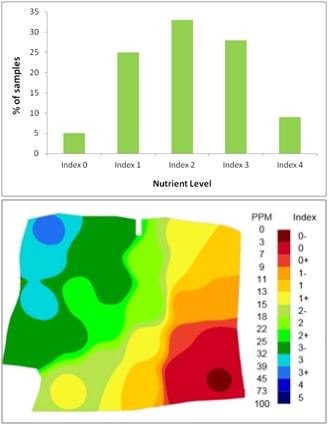SOYL Newsletter September 2015
1. Address soil health to increase crop successWhile combining this harvest, many farmers will be mapping their yields with specialist software that enables them to easily analyse the performance of individual fields. Where problem fields are persistently underachieving, a comprehensive soil analysis report of your farm can help; after all, a crop cannot succeed if the starting condition of the soil is inadequate. With increasing pressure to hit yield and protein targets, more and more farmers are conducting soil testing to make sure each field fulfils its potential.
From a whole field composite sample, SOYL's Field Health Check includes analysis of:
- Macronutrients
- Micronutrients
- Cation exchange capacity
- Organic matter content
- Soil pH
- Soil texture.
For more information on the Field Health Check, please contact your local SOYL representative or call SOYL on 01635 204190.
2. Check nutrient levels to boost yields and reduce costs
 Nutrient sampling is now well underway and the data collected is key in identifying variation in levels of phosphate, potash, magnesium and pH in the soil. Areas below target indices can have a detrimental effect on the overall performance of a field and significant yield penalties can be incurred.
Nutrient sampling is now well underway and the data collected is key in identifying variation in levels of phosphate, potash, magnesium and pH in the soil. Areas below target indices can have a detrimental effect on the overall performance of a field and significant yield penalties can be incurred.By combining nutrient maps with variable rate recommendations, these areas can be easily identified and treated with increased applications of fertiliser to ensure optimum yields are achieved and soil nutrient levels are improved.
Nutrient maps are also used to identify areas which are above target indices and therefore would not agronomically or economically benefit from applications of fertiliser. This means fertiliser savings can be made and costs can be reduced.
The graph opposite shows the % distribution of phosphate levels in over 200,000 soil samples taken in 2013. The data shows that over 30% of the analysed hectares did not require phosphate applications as they were above the target index required. At the other end of the scale, 30% of samples were below the target index, so would need an increased rate of fertiliser.
This range in phosphate levels is common in individual fields. The map opposite illustrates a field which has an index range of 0 to 3+. This difference in phosphate availability in the soil clearly shows how precision farming techniques produce good yields by variably applying fertiliser according to the measured nutrient level.
To book nutrient sampling for your land, speak to your local SOYL contact or call Rebecca Kearsey on 01635 204190.
3. Identify ideal seed rates with soil scanning
By using more seed where it's needed and avoiding surpluses in other areas, variable rate seeding can improve yields. To find the ideal figures for late autumn drilling in your fields, there is still time to conduct scanning.
After scanning is conducted, soil analysis is completed and growers receive their data through MySOYL, which enables variable rate seed plans to be created from the farm office. A seed rate calculator makes this possible; along with the soil analysis data, this tool generates plans by using one of these three options:
- A target average seed rate as kg/ha
- The TGW of the seed and a target seed population as seeds/m2
- The TGW of the seed and a target plant population as plants/m2.
Training sessions and quick guides are available to help with the calculations; call the MySOYL support team on 01635 204190, or speak to your local SOYL contact.
4. Meet Clair Taylor
"When I started working for SOYL as an administrative assistant in 2012, my only crop experience was growing runner beans in the garden! My background was in events co-ordination and administration in educational services, but I found the transition was an easy one with the help and guidance of some very talented people sharing their wealth of knowledge.
My main responsibilities are giving support to growers when they contact us and also to our sales team, office staff and samplers with all their administration needs. I also arrange all SOYL meetings and events.
I am part of the PK team too, which is responsible for delivery and quality control of the nutrient map process. It's peak time for the team at the moment so we're busy making sure that maps are accurately processed and turnaround times are kept to a minimum so that customers are receiving the best possible service.
In our bid to provide this first class service, I also conduct customer service training for SOYL staff which includes how to handle phone calls and deal with queries in a professional, friendly and consistent way.
Last year I helped to organise and run the SOYL Winter Workshops. I got to meet lots of growers and learn much more about how SOYL services meet their needs and expectations and benefit their business. We're currently in the process of organising some exciting opportunities for our growers for this winter; watch this space!
SOYL is great to work for and I feel privileged to have such friendly and knowledgeable colleagues. The company is always looking for new innovative ideas to help growers and I can’t wait to see what's coming next!"
Don’t forget you can follow us on Twitter @SOYLprecision for regular updates on soils, nutrients, machinery and GPS.










